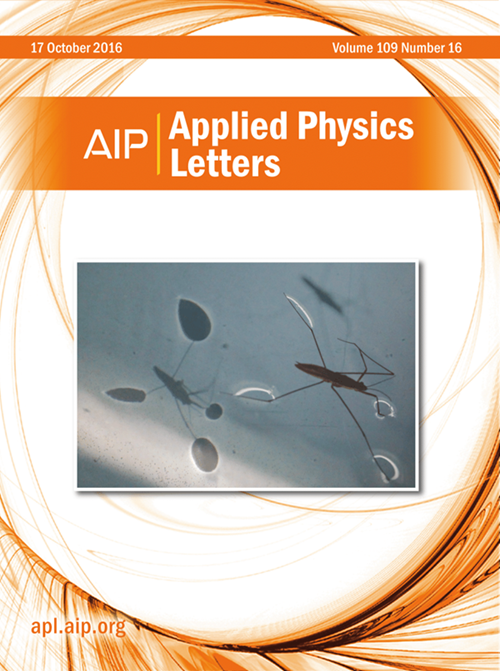fe -有序Fe5−xGeTe2的自旋-晶格耦合和各向异性磁输运
IF 3.6
2区 物理与天体物理
Q2 PHYSICS, APPLIED
引用次数: 0
摘要
二维范德华(vdW)磁性材料在新一代自旋电子器件的开发中引起了广泛的关注。当居里温度高于室温时,vdW磁体Fe5−xGeTe2表现出可逆的自旋结构和明显的电子能带结构。通过淬火处理,Fe5−xGeTe2在晶体结构中显示出有序的Fe(1)位,在电子结构中显示出非平凡的平带。然而,对铁有序相物理性质的详细实验研究仍然有限。在这项工作中,我们合成了fe -有序Fe5−xGeTe2晶体,并通过多种测量相结合系统地研究了其物理性质。增强的电子比热系数(γ = 70.43 mJ mol−1 K−2)和Kadowaki-Woods比(A/γ2≈2.6 μΩ cm mol2 K2 J−2)证明了平带和强电子相关性的存在。此外,观察到强自旋-晶格耦合,其中磁相变与晶格振动和拉曼光谱位移相吻合。此外,各向异性磁输运特性揭示了有序相中Fe(1)磁矩与载流子之间的耦合。我们的研究结果为fe有序相中的平面带提供了进一步的实验证据,并为利用vdW异质结构中自旋和晶格动力学之间的协同作用来设计可调谐自旋电子器件提供了一种策略。本文章由计算机程序翻译,如有差异,请以英文原文为准。
Spin–lattice coupling and anisotropic magneto-transport in Fe-ordered Fe5−xGeTe2
Two-dimensional van der Waals (vdW) magnetic materials have attracted extensive attention for the development of next-generation spintronic devices. The vdW magnet Fe5−xGeTe2 exhibits reversible spin structure and distinct electronic band structures tuned by thermal process with the Curie temperature (TC) above room temperature. By using a quench process, Fe5−xGeTe2 shows Fe(1) sites ordered in the crystal structure and nontrivial flatbands in electronic structures. However, detailed experimental investigations of physical properties in the Fe-ordered phase remain limited. In this work, we synthesize the Fe-ordered Fe5−xGeTe2 crystals and systematically investigate the physical properties by the combination of multiple measurements. The enhanced electronic specific heat coefficient (γ = 70.43 mJ mol−1 K−2) and Kadowaki–Woods ratio (A/γ2≈ 2.6 μΩ cm mol2 K2 J−2) provide evidence for the existence of flatbands and strong electron correlations. Furthermore, strong spin–lattice coupling is observed, where magnetic phase transitions coincide with lattice vibrations and Raman spectral shifts. In addition, anisotropic magneto-transport properties reveal the coupling between Fe(1) magnetic moments and charge carriers in the ordered phase. Our results provide further experimental evidence of the flatbands in the Fe-ordered phase as well as offer a strategy for designing tunable spintronic devices by exploiting the synergy between spin and lattice dynamics in vdW heterostructures.
求助全文
通过发布文献求助,成功后即可免费获取论文全文。
去求助
来源期刊

Applied Physics Letters
物理-物理:应用
CiteScore
6.40
自引率
10.00%
发文量
1821
审稿时长
1.6 months
期刊介绍:
Applied Physics Letters (APL) features concise, up-to-date reports on significant new findings in applied physics. Emphasizing rapid dissemination of key data and new physical insights, APL offers prompt publication of new experimental and theoretical papers reporting applications of physics phenomena to all branches of science, engineering, and modern technology.
In addition to regular articles, the journal also publishes invited Fast Track, Perspectives, and in-depth Editorials which report on cutting-edge areas in applied physics.
APL Perspectives are forward-looking invited letters which highlight recent developments or discoveries. Emphasis is placed on very recent developments, potentially disruptive technologies, open questions and possible solutions. They also include a mini-roadmap detailing where the community should direct efforts in order for the phenomena to be viable for application and the challenges associated with meeting that performance threshold. Perspectives are characterized by personal viewpoints and opinions of recognized experts in the field.
Fast Track articles are invited original research articles that report results that are particularly novel and important or provide a significant advancement in an emerging field. Because of the urgency and scientific importance of the work, the peer review process is accelerated. If, during the review process, it becomes apparent that the paper does not meet the Fast Track criterion, it is returned to a normal track.
 求助内容:
求助内容: 应助结果提醒方式:
应助结果提醒方式:


